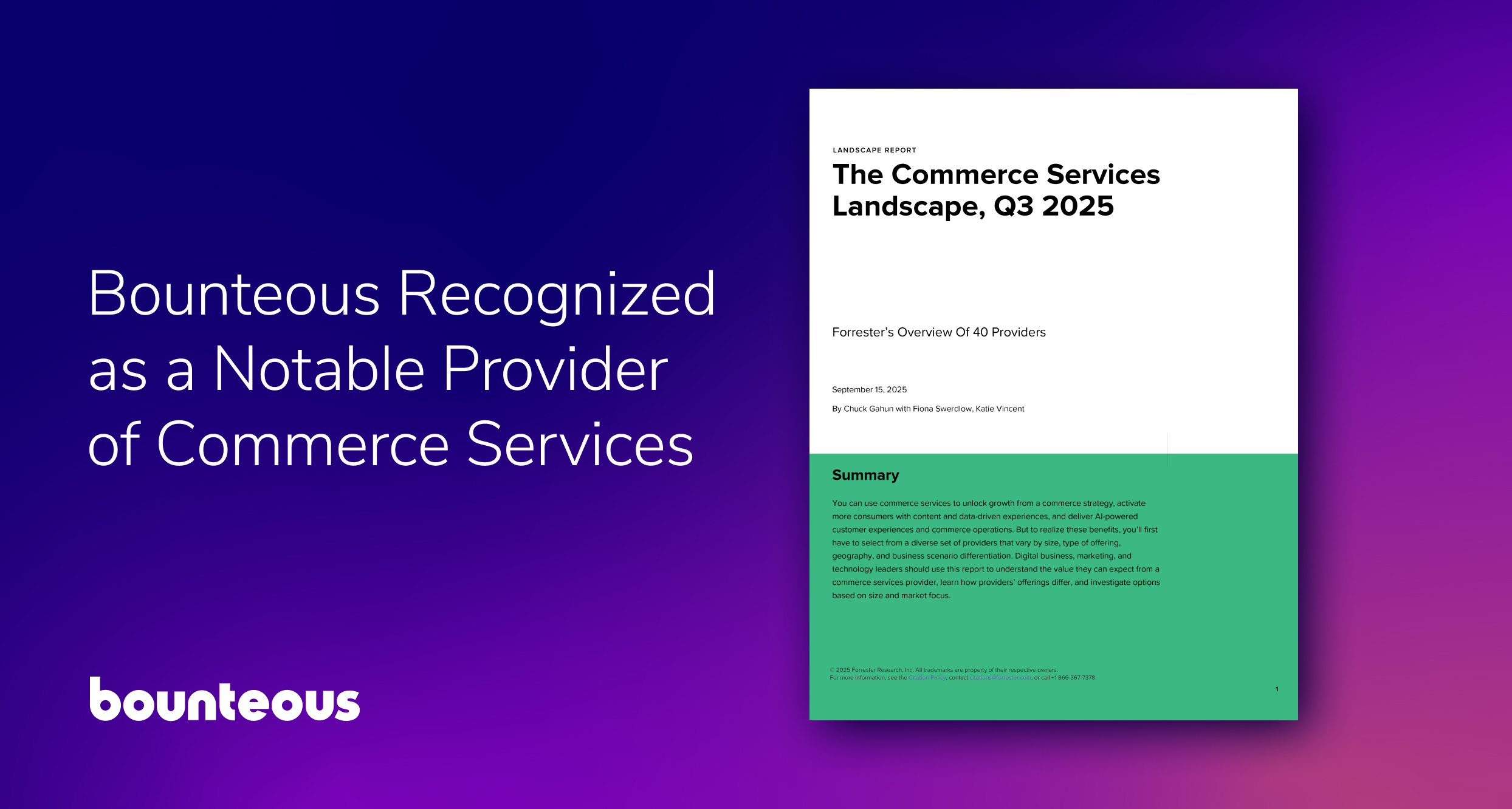10 Ways PIM Projects Fail and How to Ensure Your PIM Project Succeeds

The Bounteous Data Management practice helps clients with Product Information Management (PIM) and related data management platforms. While many of our clients are attempting to implement their first PIM platform, several clients seek our support to "save" failed implementations.
Having stepped into struggling implementations multiple times, we're sharing what we've learned to help make sure others benefit from our experience. Failing implementations can be a result of a change in leadership, vendor, or platform, or unexpected orders of magnitude increase over the initial estimated cost or time to launch.
Note that in most cases, failure doesn't mean the PIM project stops completely—a successful PIM implementation is simply too valuable. It is possible to navigate through these struggles, but the best course of action is to try to avoid them completely. What follows are the top 10 reasons we found that PIM projects fail and our advice on how best to ensure your PIM project succeeds the first time.
1. Not Getting Senior Leadership's Long-Term Commitment
PIM project sponsorships rarely come from the C-Suite. Instead, those with day in and day out product information needs are most likely to look to a PIM to address their challenges. Failing to secure senior leadership's active, ongoing PIM project participation means those responsible for a PIM implementation project are exposing the project to a much higher risk of failure. Ultimately, failure comes with not recognizing that PIM project approvals are not enough; you need to convince leadership to remain a champion of your PIM project.
Success Tip: Along with obtaining PIM project approval, be sure to secure a C-Suite champion willing to commit to remaining actively involved until the PIM project succeeds.
2. Failing to Understand How a PIM will Impact Your Organization
Virtually every department in businesses that make, distribute, or sell products will create, edit, transform or use product information. PIM can be used to support marketing, finance, and accounting, merchandising, warehouse management, shipping, manufacturing, sales, commerce, etc. Given this reality, it's important those responsible for choosing and implementing a PIM involve each department that touches product data in the PIM project.
PIM often impacts or changes jobs, which creates fear and uncertainty. Forsaking interviews and failing to steadily communicate with representatives of each department that will be impacted by a PIM greatly increases the risk of failure.
Success Tip: A Bounteous client with dozens of subsidiaries engaged us after four failed PIM implementation attempts. What we did that was different than before was we interviewed over 60 individuals across virtually every subsidiary and department of their business. We used this input to devise an implementation approach that addresses every part of the enterprise versus focusing only on the group that sponsored the PIM project. Bottom line, a successful PIM implementation must involve everyone that works with your product information.
3. Not Determining Where and How Product Data is Created, Edited, and Consumed
If your PIM is to become the "single source of truth" for your company's product information, you must know every place that product data exists and how it is created, edited, consumed, and stored. The nature of businesses is that if there is not a single source of truth that exists, departments will build work-around product data repositories that allow them to do what they need to do. Failing to uncover every place where product data lives and is used will result in a PIM implementation that fails to offer the golden record of a product.
Success Tip: While conducting interviews with every group that works with product information, make certain to document where and how this data is used.
4. Failing to Secure the Necessary Expertise
Few companies looking to implement a PIM have someone within their organization with sufficient PIM experience. Failing to find a qualified internal advisor increases risks by forcing you to rely exclusively on the vendor you choose to support your PIM implementation. Your chances of failing increase if you do not have someone on your internal team that really knows what is needed.
Hiring the right PIM expertise for your organization is extremely challenging as well—a client of ours is still looking for a PIM leader eight months after they began their search. PIM expertise requires a unique blend of deep business process, data modeling and governance, and technical integrations skills and experience. This is very hard to find.
Success Tip: Unless you have a deeply experienced PIM expert on staff, you should engage a properly vetted PIM expert at the onset of your PIM project. This expert should be able to advise on every aspect of the project for its entire duration. This is not easy to find, so get creative. For example, consider providing the expert with a bonus of some sort for remaining engaged through launch and for the successful implementation of your new PIM.
5. Not Developing Data Governance Requirements and Policies
Data governance and policies include defining business objects, constraints, attributes, taxonomy, product families, completeness, and workflow processes and controls. Failing to adequately do this work often results in a PIM whose only benefit is that all product information is in one place but is of poor quality. By defining governance requirements and policies, you will know how to set up your PIM to ensure you end up with high-quality product information. Worth noting is that you can define your data governance requirements and policies before you select your PIM.
Success Tip: Implementing a new PIM is really just the start of a company's product information journey. None of the companies that we've worked with began with a comprehensive and complete definition of the governance they ultimately wished to employ at initial launch. But by defining governance requirements and policies up front, you can make informed decisions on what needs to be in place Day One, and subsequent governance rules and policies will be added iteratively over time.
6. Failing to Adequately Understand Your Product Data
PIM projects can fail due to a company's lack of understanding of the current state of their product data. The "dirtier," more complex, and more scattered your product data is, the more it will cost and the longer it will take to implement a PIM. A client of ours had the cost and timeframe to implement their new PIM nearly tripled from initial estimates. This was due to their failure to accurately understand and convey the current state of their product data. When costs and timeframes dramatically increase, leadership might go so far as to cancel projects.
Success Tip: Perform a comprehensive and detailed analysis of your existing product data before you start looking at PIMs and vendors. The cleaner your data, the lower the cost to implement a PIM. But if you determine your data is dirty (missing attributes, inconsistent, duplicated records, etc.), complex, stored in a myriad of locations, and managed by multiple groups across the organization, your PIM implementation cost will rise. With that information in hand, you can manage leadership's expectations and get more accurate estimates of costs and implementation timelines from vendor candidates.
7. Not Understanding or Properly Addressing Product Complexity
Another big driver of cost is the complexity—the breadth and homogeneity—of your product catalog. The fewer total products and product types/families the PIM needs to support, the simpler it is to set the PIM up and the less time and cost is needed to implement. Failing to grasp and plan for your catalog's complexity can lead to meaningful cost and timeline overruns.
Success Tip: Hire or engage a PIM expert to perform an evaluation of your entire product catalog and have them document the product types that your new PIM will need to support. You should not guess at this—you or someone you assign needs to do a comprehensive analysis.
8. Failing to Understand the Capabilities and Limitations of Legacy Product Data Platforms
Implementing a PIM (see Anatomy of a PIM Implementation) requires getting product data from legacy platforms and product data stores into the new PIM. With many organizations, the systems and solutions used to manage product information are over a decade old and lack APIs or even the means to generate export files (e.g., CSV) that can readily be loaded to your new PIM platform.
While discovering this after the fact won't likely cause a PIM project to fail, finding this out after developing your implementation plans will lead to increased costs and delays associated with developing complex ETL solutions to extract attributes, values, and product data into export files that can be readily loaded to your new PIM.
Success Tip: Merely identifying every place product information is stored and used is not sufficient. Be sure to take the extra step to determine if anything extra is needed to get this data out of your legacy solution and into your new PIM.
9. Failing to Fully Understand Integration Requirements
Modern tech stacks can include ERP, DAM, CRM, PLM, CDP, MDM, Publishing Automation, Syndication, Commerce, Marketing Automation, etc., platforms and frameworks. While every PIM implementation is different, PIMs are often integrated with multiple platforms, either directly or through periodic syncs. Every integration takes time and investment so developing a clear understanding of what it takes to integrate each needed platform with your new PIM is critical.
Success Tip: Similar to understanding product data locations and uses, it is critical to develop a comprehensive understanding of the platforms and solutions that you will or would like to integrate with your new PIM. While certain platforms are obvious (e.g., ERP and commerce are generally a part of the initial implementations), gaining an up-front understanding of other integrations will help you set priorities and future expectations.
10. Not Understanding that PIM is Journey
Committing to implementing a PIM is just the first step in a long journey. This is partly due to a PIM's ability to provide meaningful value even when only a modest percentage of the platform's overall capabilities are used. For example, many PIMs include workflow support for enriching product data. However, few companies invest in enabling workflow management before using the PIM to improve downstream solutions. Not recognizing that PIM is a journey won't lead to failure but if you do not effectively manage leadership expectations, future investments could be moderated, which could make reaching the full potential of your new PIM platform harder to achieve.
Success Tip: Take the time to put together an implementation plan that goes well beyond the initial launch of your new PIM. As important, explain why certain features and capabilities are not part of the initial launch and when and what it will take in the future to enable these post-launch.


